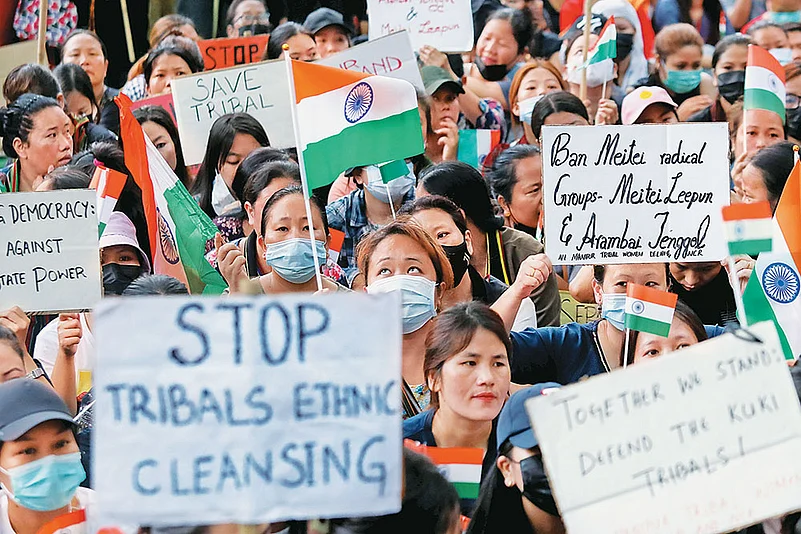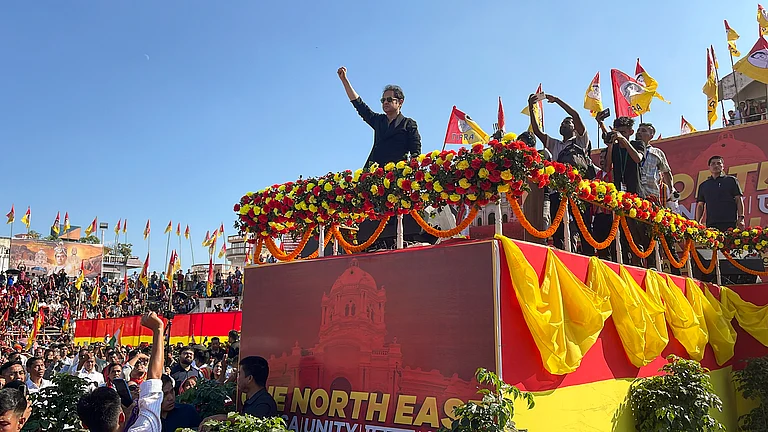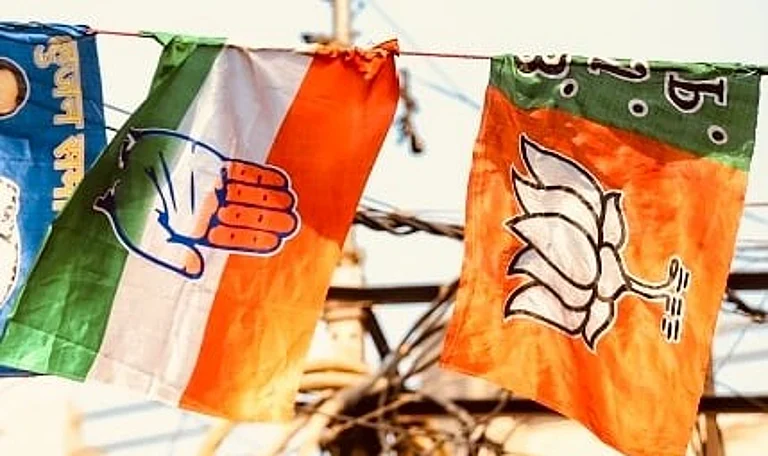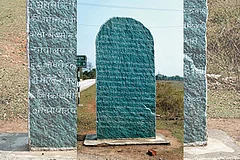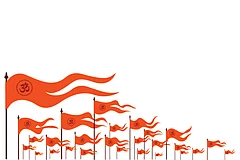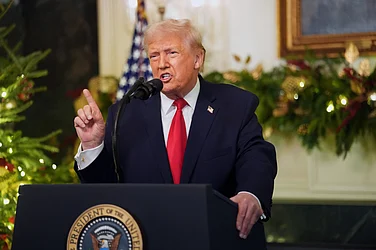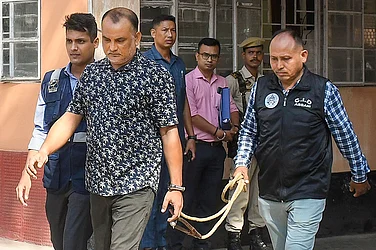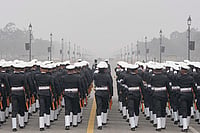The roads leading to the Mini Secretariat in the Kuki-dominated Churachandpur district of Manipur were chock-a-block with hundreds of protesters on February 15 when security forces opened fire. A 15-year-old Kuki youth, resident of the nearby S Canan Veng village, was passing by the commotion, on his way home, when a bullet hit him, killing him instantly. A desolate father, Seilal Haokip has dubbed the death of his minor son as an “institutional murder”. Another civilian, Letlalkhuol Gangte, 29, lost his life in the firing which left 25 people injured. The tragedy seems to have only galvanised the tribals further in their resolve to sever ties with the dominant Meitei community.
Clashes between the Kuki and Meitei communities broke out first on May 3, 2023 and have since consumed over 180 lives. While violence has become endemic across Manipur, the recent conflagration was triggered by the sudden suspension of the Kuki-Zo head constable, Siamlalpaul, posted at Churachandpur, after images of him taking selfie videos with “armed men” went viral on social media on February 14. In protest, around 300-400 Kuki-Zo protesters mobbed the offices of Churachandpur’s Superintendent of Police (SP) Shivanand Surve and Deputy Commissioner (DC) S Dharun Kumar. While security forces claim that the firing was in retaliation to mob violence, the Indigenous Tribal Leaders’ Forum (ITLF) has held the SP and DC “entirely responsible” for the deaths. The group has warned that “both the SP and DC will bear the responsibility of any untoward incident that may fall on them”, should they choose to stay in Churachandpur. The ITLF’s spokesperson, Ginza Vualzong, tells Outlook that suspending a tribal official for a selfie while ignoring Meitei officials ‘openly fraternising’ with armed militants reflects the state’s “anti-tribal” agenda to vilify the Kuki-Zo people. The irate activist adds that the ‘miscreants’ in the viral photograph clicked by Siamlalpaul were volunteers of the village defence force, and not “dangerous members of any Suspension of Operations (SoO) groups as is being touted in the media”.
After nine months of violence, Manipur remains on the boil. The BJP, which has been cultivating its tribal vote bank across the country, has maintained a stoic silence on the Manipur issue, despite repeated raps from opposition leaders and international human rights agencies for its failure to restore peace in the state. Between the Nagas—who have largely remained neutral in this war—and the Kuki-Zo tribes that inhabit the contiguous hills of Manipur and Myanmar, the party seems to be relying on a third kind of “tribal”.
“By aligning with the tribals in Manipur, the BJP seems to be throwing its weight behind a dominant, ‘general category’ community’s demand for Scheduled Tribe (ST) status. It’s a distorted kind of tribalism,” says Albert L Renthlei, convener of Zo United, a conglomerate of Manipuri and Mizo tribal groups. Renthlei finds it strange that Meiteis, who have claimed to be ‘advanced’ people and denigrated Kuki tribes with derogatory monikers like hao or lawai macha (uncivilised), now want to be categorised as “backward”.
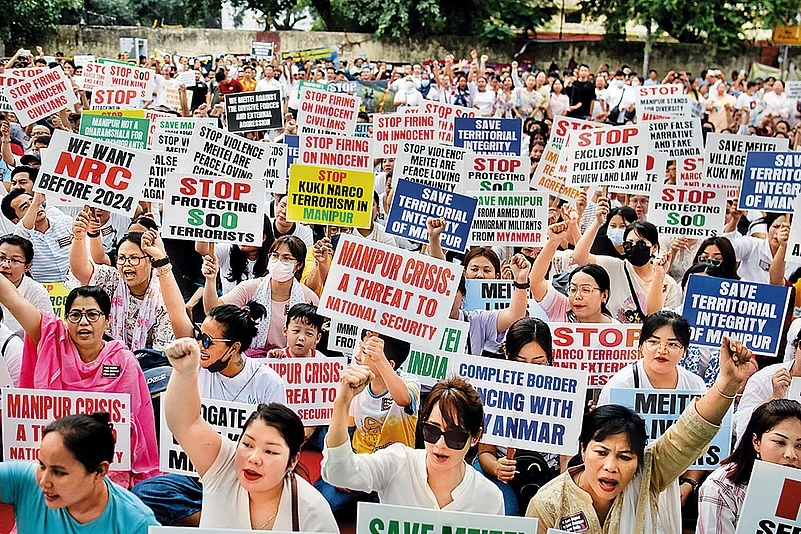
“Backward castes or tribes did not choose this status,” Renthlei adds dryly. “Benefits given to STs are not freebies, but affirmative action meant to reverse decades of injustice”. The Meiteis allege being “denied” ST status today, but when the first Backward Class Commission had requested a list of tribes to include in the Scheduled Tribes (modification) list from states and union territories, the Meiteis chose not to include themselves.
Many Meiteis today believe that ST categorisation is the only way to protect their “ancestral land, traditions, culture and language”. But why switch sides now, after all these years?
The Manipur Land Revenue and Land Reforms Act, 1960, prohibits non-tribals from buying or owning land in “hill areas”. Some Meitei historians, nevertheless, claim that the old kingdom included five present-day districts of Imphal East, Imphal West, Thoubal, Bishnupur, and Kakching. Acquiring tribal land is said to be essential for accommodating the expanding valley population, which is relegated to just 10 per cent of Manipur.
“Meiteis, who have hitherto considered themselves an ‘advanced’ people, now want to be categorised as “backward.”
Beyond the more practical needs, Leishipem Khamrang, a professor at the Royal Thimphu College in Bhutan, argues that the Meitei demand for ST status may also be in part driven by a need for cultural preservation. “Considering the various agendas and propagandas disseminated by Meitei organisations, the demand for ST status is a manifestation of the Meiteis’ intention of salvaging their own lost cultural supremacy, language and identity,” notes Khamrang.
In a paper exploring latent ethnic relations and enmity in Manipur, the professor outlines how Hindu proselytisation shaped Manipur in the 18th century when King Gharib Nawaz (Pamheiba) made Hinduism the official religion, and even changed the Meitei name of his kingdom ‘Kangleipak’ to the Sanskritised ‘Manipur’.
This “annihilation of centuries-old traditional religion and social system of the Meitei” was followed by systematic Sanskritisation and Brahmanisation of indigenous customs. Meitei salai (clans), for instance, were absorbed into the Hindu gotra (lineage) system; each salai was identified as a gotra. “The king’s dynasty (declared as Kshatriya) had been equated with the Surya vansa or solar dynasty of Sri Ramachandra of Ramayana,” says researcher Senjam Purnima Devi. Meitei festivals like the Waira Tenkap festival of archery evolved into the worship of Lord Rama and the Kongba Leithong Phatpa festival became Vishnu Sankranti. Meitei deities like Panthoibi were likened to Durga while Nongpok Ningthou became Shiva.
Devi, who penned the 2018 paper Syncretic Pre-Hindu Religious Elements In Hinduism, says that despite the imposition of Vaishnavite Hindu traditions by the ruling class on its indigenous subjects, Meiteis retained parts of their pre-Hindu religious practices and rituals leading to a distinct mix of Hinduism and Sanamahism that exists even today. “Sanamahi is worshipped in the traditional south-west corner of almost every Meitei household along with the goddesses Imoinu, Phouoibi, Panthoibi and a myriad of deities,” writes Devi.
While these deities are worshipped inside homes, outside spaces are devoted to private or community temples where the Meiteis worship Vaishnavite deities like Ram-Sita, Hanuman and Krishna-Radha. In the women-run market of Ima Keithel, it isn’t uncommon to find images of Sanamahi symbols and deities being sold alongside stuffed cloth idols of Krishna and Rama, who sport traditional Meitei clothes with distinctly Manipuri facial features and Meitei costumes.
Meitei revivalism has surged over the past few decades. By the late 1970s, prominent politicians like Yangmaso Shaiza, Keishamthong Laishram Manaobi and activist Chingshubam Akaba came to the forefront of Meitei identity politics, culminating in the slow, yet steady revival of the indigenous Meitei Mayek script Manipuri kings used before the advent of Hinduism.
During the past year, radical Meitei groups have breathed fresh life into indigenous revivalism, albeit spiced with a hint of saffron. Groups like Arambai Tenggol, commandeered by the elusive Korounganba Khuman and a key perpetrator of violence against the Kukis, have risen in political prominence. Meitei Parliamentarian and Manipur’s titular king, Leishemba Sanajaoba, is sympathetic towards the Tenggol. Photos of Khuman meeting him and Manipur Chief Minister N Biren Singh at his residence surfaced online last August. But perhaps the most powerful visuals of Arambai Tenggol’s growing footprint in Manipuri politics came two days ahead of Republic Day when nearly 37 MLAs and three MPs made their way to the medieval-era Kangla Fort—a symbol of Meitei pride—in response to a “summons” sent by the group’s chief.
At the “meeting”, the lawmakers were allegedly compelled to take an “oath” to protect the “integrity of the state” and pledged to fulfil the group’s demands within 15 days. While Singh did not attend, he has reportedly signed the document as well. Incidentally, delisting certain Kuki-Zomi tribes from the ST category is one of the group’s key demands. “How can the government allow such an unconstitutional event?” asks Renthlei. “Who is running the Manipuri government now, Meitei leaders or Meitei militants?
MORE FROM THIS ISSUE
Meanwhile, in Churachandpur, which the tribals have renamed “Lamka”, the mood is grim but steadfast. Renthlei, Vualzong and other tribal leaders who recently met Union Home Ministry officials have reiterated their demand for a separate administration for hill districts. “We don’t see any way for Kukis and Meiteis to coexist anymore,” says Renthlei. Cut off from the state’s political and economic centre, Kuki communities have been struggling to rebuild their lives after the violence. Over 50,000 people have been displaced in the conflict and the hills are today overcrowded with relief camps awaiting aid from the government. “Both sides have suffered in this violence. Going separate ways is the only way to bring peace,” adds Renthlei.
(This appeared in the print as 'Status War')






